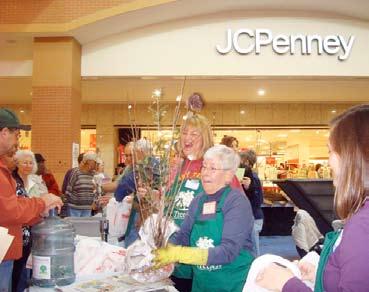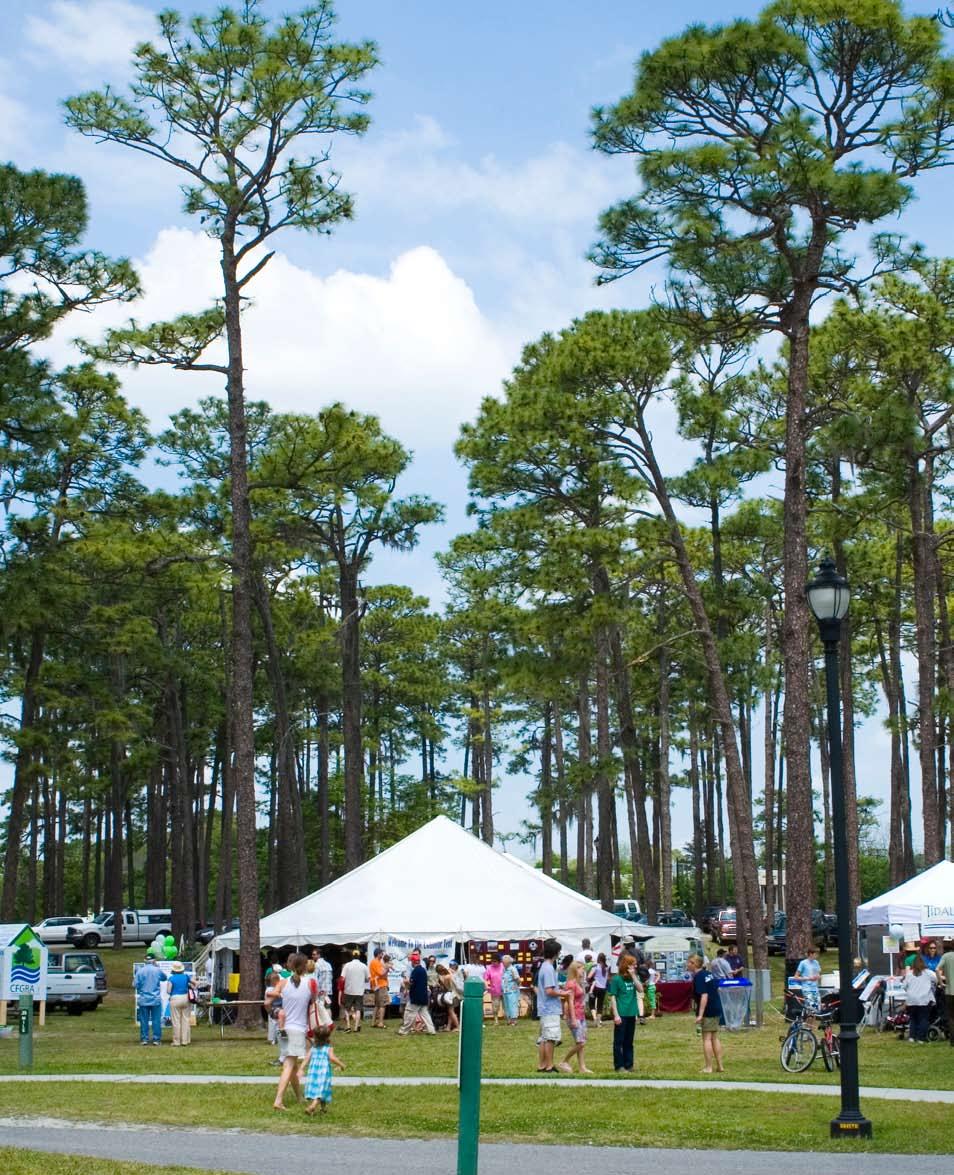

Letter from the Editor
Welcome to the Earth Day 2009 issue of Cape Fear’s Going Green!
Earth Day, first celebrated thirty-nine years ago, falls officially on April 22. But as we learn more about the balance of life on earth and our impact on it, it has become common to schedule a week or more of activities honoring sustainability.
As I looked over the photos of last year’s Earth Day, I realize what is happening in our corner of the world. And I am encouraged by so many things.
I’m encouraged by the phone calls and emails I get from people starting their own new green business. I’m encouraged by those who are taking advantage of slow times to develop skills that will sustain them as the economy picks up. Encouraged by the turnout at local meetings, as folks choose to question industries and practices that affect the quality of our air and water. Encouraged that local interest in rain barrels continues, even as our three-year drought eases.
Encouraged by the growth of Community Supported Agriculture, and of community gardens in the Cape Fear area. The National Gardening Association reports that 43 million U.S. households plan to grow part of their food this year. My sister reports that garden stores in Eugene are running out of seeds as residents there scramble to put in “Victory Gardens.”
I bought several native plants last year, but didn’t manage to get them into the ground before winter. They soon withered and died back: every few weeks I considered throwing them into the compost bin. Surely they couldn’t still be alive?
But as April warmed up I noticed healthy green shoots coming up from the roots of the native plants—a reminder of the wisdom of working with the earth, instead of against it. The earth knows exactly what and when to grow. In the same way, I see the green shoots of our community emerging. The response at recent events like the Rachel Carson documentary or MoveOn’s Green Jobs Forum was overwhelming: attendees eagerly sought me out for ways they could make a difference in the coming weeks. Everywhere I turn I see the green shoots. You can find many of these opportunities listed on pages 19–23., May your gardens thrive this spring and may you, too find encouragement in the green shoots. Look around you: they are everywhere!
Valerie L. Robertson EditorContents
3 Greenhouse Club Encourages Gardeners
6 Your Ecological House Want To Go Green? Add A Greenhouse
7 Great Backyard Bird Count
8 Progressive Gardens
10 Dwarf Palmetto
12 Earth Day 2009
14 A Golden Opportunity—Monteith LEEDs the Way
16 Alternative Fuel Car Show Comes to Wilmington
18 Business News
18 Commuting
19 Make Every Day Earth Day: Things You Can Do Year Round!
20 Make Every Day Earth Day: Local Environmental Resources
23 Calendar
24 Celebrate Arbor Day at D.C. Virgo Middle School
24 2009 Wilmington Tree Commission Tree Preservation
and Landscape Awards
24 TreeFest Proves Popular
Cape Fear’s Going Green is a quarterly publication promoting eco-friendly resources and lifestyles in the Lower Cape Fear River Basin.
Publisher & Editor in Chief: Valerie Robertson
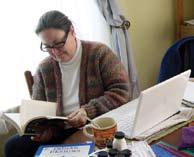
Sister City: Eugene, Oregon (Voted “Greenest City” 2006 by The Green Guide) Eugene Contributing Editor: Mary Robertson
Advisors & Editorial Contributors: Lawless Bean, Donald Butzin, Melva Calder, Sean Carr, Martin Friedman, Kate Gernatt, Alistair Glen, the Kuuskoski family, Christopher Lymberis, Katie Mallard, Scott Ogden, Christie Perry, Cary Ralston, Adeline Robertson, Christina Simon, Philip S. Wenz, and Andy Wood.
Cape Fear’s Going Green Going Green Publications
P. O. Box 3164 Wilmington, NC 28406 (910) 547-4390
www.goinggreenpublications.com
Cape Fear’s Going Green is available by subscription or on our Web site. Print copies are available at more than seventy-five area eco-friendly businesses and locations, including:
B + O Design Studio, Coastal Glass Tinting, The Napping Cat, Old Growth Riverwood, Old Books on Front Street, Pomegranate Books, Progressive Gardens, Sambuca, Sapona Green Building Center, Tidal Creek Co-op, UNCW, WHQR, and the Shelton Herb Farm booth at area farmers’ markets.
Editorial: If you have story ideas or calendar items to suggest, email us at editor@goinggreenpublications.com, or call (910) 547-4390.
Advertising information: Email ads@goinggreenpublications.com.
Cape Fear’s Going Green is distributed free through Brunswick, New Hanover, and Pender counties. If you have a business and would like to receive multiple copies for the public to pick up, please contact us.
Greenhouse Club Encourages Gardeners
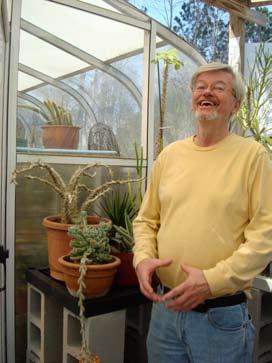
You don’t have to own a greenhouse to belong to the Hobby Greenhouse Club—you just have to have a love of gardening. In fact, many of the group’s members have no intention of ever acquiring a greenhouse, but enjoy the camaraderie of others who share their interest in hands-on work with plants.
Once a month the members of this group, from all walks of life, assemble at the Arboretum to share plants, information about plants, and friendship.
At a recent meeting there was a presentation on green roofs by Steve Mott of Mott Landscaping, followed by discussion to plan the then-upcoming annual greenhouse tour. Some brought plants to share with other members (seedlings and seeds alike) and there were snacks and time to talk with club members.
The “plant-sharing” at the end of club meetings has proven very popular. Members are encouraged to bring not only plants, but cuttings, bulbs, seeds, roots–anything garden-related. Any items left on the table at the back of the room are fair game, and represent a wonderful way to diversify your plant collection...or perhaps to pick up material for some extra reading.
The group attracts beginning gardeners and people who’ve been gardening–some even commercially–for many years. The club is a great resource if you’re new to gardening. No matter what your interest–growing food, propagating lilies, or designing a camellia landscape–it’s likely that one of the club’s 150 members will share your interest or have expertise to offer.
In addition to sharing information with club members at monthly meetings, the group is very active in reaching out to offer information to members of the community around them. Their annual greenhouse tour, held in early spring, allows members of the public to learn about the wide variety of greenhouse situations available for different needs. Judy Thomas’ greenhouse lets her start seedlings early for her extensive vegetable gardens, arranged in a pleasing pattern of raised beds. She also can overwinter favorite plants, providing
The Hobby Greenhouse Club welcomes visitors and new members to its monthly meetings the second Tuesday of each month, to hear speakers on a variety of subjects.
Coming Soon:
May 12 Monthly Meeting 7:30 p.m.
May 29 & 30 Summer Plant Sale
June 9 Monthly meeting 7:30 p.m.
Meetings are at the Arboretum, 6206 Oleander Drive
Plant Sales are at 2318 Metts Avenue www.hobbygreenhouseclub.org
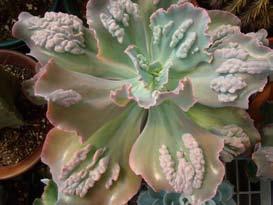
For more information contact Club President Amy Finelli (910)398-7603 hobbygreenhouse@aol.com
them haven through the cold without bringing them inside her house. Margaret Shelton depends on her large greenhouses for the herbs she grows commercially and sells at local farmers markets. And others merely want a small space to get a head start on spring by sowing their vegetable seeds early. Even those who have no plans to acquire a greenhouse can learn valuable information about growing.
The Hobby Greenhouse Club holds popular community plant sales every spring and summer, behind one of the homes on Metts Avenue in Wilmington. Sale proceeds allow the club to support projects that further plant education in the community at large.
The Club helped build and presently maintains the George Ross Memorial Greenhouse at the New Hanover County Arboretum on Oleander Drive. George Ross was a founding member of the Hobby Greenhouse Club. The club supports a number of community service projects: it contributes funds in support of the Ability Garden at the Arboretum, as well as area 4-H clubs. Currently the group provides funds to area community colleges for horticultural scholarships, both at Cape Fear Community College and Brunswick Community College.
Understanding the origins of the Hobby Greenhouse Club requires some mention of six families who were neighbors fifty years ago.
History of the Metts Avenue Gardens
In the early 1960s the six families living from 2318 to 2400 Metts Avenue in Wilmington combined their 700- to 1000-foot deep backyards into one enormous area and called it “Plantation Gardens.” The informal gardens featured a wide variety of trees and plants, primarily camellias, dogwood trees and of course
(Greenhouse Club, continued)
many azaleas. It included open spaces and walking paths between the various properties. Over the years the properties have changed as home owners came and went but the gardens and paths were generally maintained. Anyone selling one of the homes tried to sell it to someone who would appreciate the gardens.
At its largest, the gardens extended east two houses to the Talley/Beale residence and three houses to the west to the Perry/Millican property. The Perry garden, originally owned by Alec and Louise Beale Millican, was on the first Azalea Festival Garden Tour in 1953, before the existence of Plantation Gardens, as well as subsequent tours. In 1966, 1973, and 1979 the properties from 2318 to 2400 Metts Avenue, known then as “The Plantation,” were on the Azalea Festival Garden Tours.
No detail was overlooked in the creation of Ira and Marie Lowe’s two beautiful attached greenhouses, which appeared most recently on the 2008 Greenhouse Tour. Even the PVC pipe of the watering system is colored to match the wood.
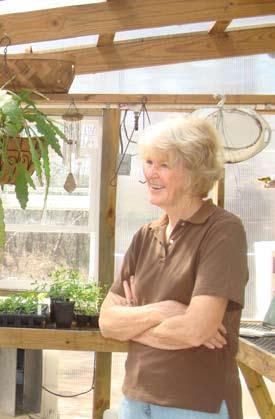
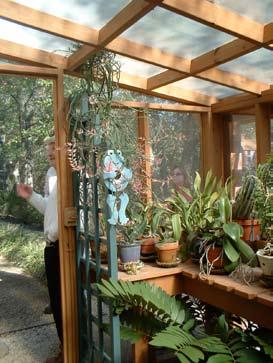
History of the Hobby Greenhouse Club

Over the years, several greenhouses were built on the various properties along Metts Avenue for plant propagation and for over wintering tropical plants. In the late 1960s George Ross and Cape Fear Technical Institute (now known as Cape Fear Community College) began holding
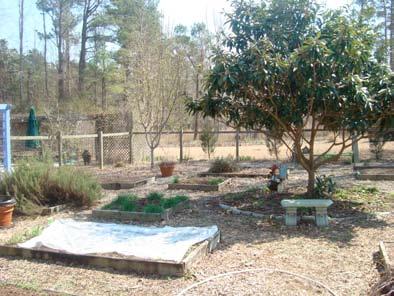


Judy and John Thomas live on 35 acres outside of Rocky Point, giving them ample space for their raised garden beds, where they grow much of their food. Shown here at the very beginning of the growing season, their arrangement creates pathways for easy work space as well as a shady spot to sit and enjoy the garden and the wilderness surrounding it.
(cont. on page 5)
(Greenhouse Club, continued)
classes and workshops on horticulture for amateurs in George’s main greenhouse. One class was called the Hobby Greenhouse class. Even after the class had concluded, many of the students continued to meet as a sort of support group. That led to the formation of the Hobby Greenhouse Club. The Hobby Greenhouse Club remains active to this day, holding monthly meetings with featured speakers on varied topics.
Heritage of Plantation Gardens
The plant sales held twice yearly by the Hobby Greenhouse Club are held on the Ross property, affording visitors a chance to visit the garden on those days. A stroll to the back of the garden can continue to the creek running behind all the properties, or can follow the signs to cut across to either the Talley garden or the Perry garden. Both of these are maintained in a way that lets one imagine what it might have been like when all six gardens formed one enormous area running behind all six properties. The Perry garden was on the Azalea Festival Garden Tour
10’ reinforced poly covered hobby greenhouse as winter protection for his geraniums, citrus, and collection of tropical Bonsai plants. It’s easy to remove in spring, allowing him to reclaim use of his sidewalk.
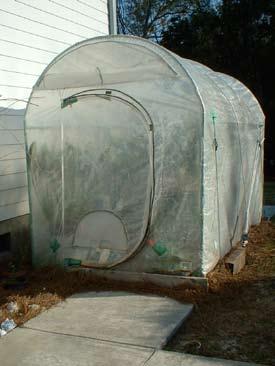
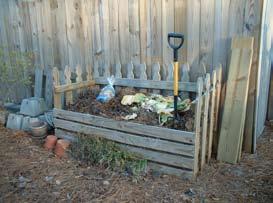
recently; it includes a water garden and brook area that invite you to sit and enjoy
the serenity of the view and the sound of falling water.
If you love gardens and gardening, whatever your level of gardening expertise, visit the plant sale and get acquainted with the Hobby Greenhouse Club. You’ll meet some of the friendliest gardeners around.
Hobby Greenhouse Club Summer Plant Sale May 29-30, 2009
Plant sales held by the Hobby Greenhouse Club are unusual because the group only sells plants that have been propagated and grown by club members. This means that everyone selling plants has first-hand knowledge of the plants the’ve brought, and they are happy to discuss plants with all who show an interest.
The selection is extensive, as the growers range from hobbyists who happen to have a few extra offspring of a favorite plant, to club members who are commercial growers. One can find houseplants, vegetable starts, and even trees. Because the available plants have all been propagated locally, buyers can know that the plant they take home is already acclimatized to local conditions. There’s always a table of small houseplants intended for children, so every child can take a plant home for free, as well as tiny packets of seeds that members have packaged themselves.
Allow extra time to stroll down to the back of the property and follow the arrows to neighboring gardens open for tour.
The next plant sale will be held May 29 and 30, behind the house at 2318 Metts Avenue. Attendance is free,
Herbs • Vegetables Natives
Mike Caulder, Jr. built this greenhouse himself out of recycled windows and doors. A side yard surrounded by picket fence holds several raised garden beds. A small compost sits bin outside the fence. This greenhouse and garden were featured on the 2008 Club Tour.
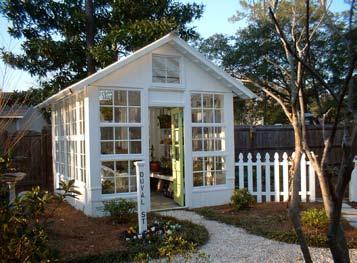
your ecological house™ Want To Go Green? Add A Greenhouse
by Skip WenzHave you been indoors a lot this winter, and feel like you could use more elbow room? Are your heating bills causing anxiety? Do you miss gardening and fresh food?
If so, you might consider building a greenhouse, attached to your main house, during this summer’s construction season. By next winter, you could have more living space, lower heating costs and a yearround garden in most climates. And all for about one fourth the cost of adding on a traditional room the same size as your greenhouse.
Greenhouses trap warm air. The sun’s rays pass through the greenhouse’s transparent walls and roof and strike the opaque floor and walls within, warming them. The floor and walls, in turn, warm the air around them, and the warm air remains within the confines of the greenhouse.
On a cold, sunny day, you can have a comfortable lunch in your greenhouse, and your plants will love the summer-like temperatures. Also, some of the warm air can be moved into your house through ducts, either by natural convection (warm air rises) or by using a small fan. It works beautifully—so long as the sun is shining.
But when the sun sets or is obscured
by clouds for several days in a row, the greenhouse can rapidly lose its heat through its glazed (glass or plastic) surfaces. It could potentially draw heat from the main house and even require heating to keep the plants from freezing. Heating a greenhouse is expensive and can completely reverse its environmental benefits.
The solutions are heat storage, insulation and isolation. Heat from the sun can be stored simply and inexpensively by building the greenhouse floor and walls with dense, heat-retaining material such as concrete, concrete block or brick. The sun warms these “thermal mass” materials, which retain heat and then slowly release it at night.
But thermal mass by itself cannot keep an uninsulated greenhouse warm; the glazing loses heat too quickly. Even double-glazed (dual pane) windows and skylights are inadequate. While double glazing is two to three times as resistant to heat loss as single glazing, double-glazed windows still lose five times as much heat as a typical insulated house wall.
To conserve heat, you’ll have to cover the greenhouse glazing with insulated panels or curtains at night. Sliding or folding panels and a variety of insulated curtains can be purchased and adapted to fit individual greenhouses. (Automated insulating panel systems are available, but they can be expensive and sometimes unreliable.)
can be addressed with natural ventilation—opening vents at the top and bottom of the greenhouse so the warm air flows up and out—and shading provided by awnings or similar devices.
A well-placed deciduous tree can make an ideal partner for a greenhouse. The tree drops its leaves in winter, allowing the sun to warm the greenhouse, and grows them back in the summer, providing shade.
Greenhouses can be custom designed or built from prefabricated kits, modified to fit your home. They can be built by contractors or by homeowners who have some construction skills and want a rewarding challenge.
If you decide to build your own attached greenhouse, draw complete plans and get a building permit. Consult an engineer to avoid potential safety hazards such as vulnerability to wind and earthquake forces. All overhead glass must be safety glass; recycled windows aren’t allowed overhead.
Greenhouse design involves many considerations such as solar orientation, shading, the type of thermal mass and glazing, weatherproofing and aesthetics. Fortunately, an Internet search for “attached greenhouse” yields a wealth of valuable, free information to help you plan your ecological greenhouse.
Cultivating Earth-Friendly Gardens
Since 1992
Pre-Development Consultation
Water-Thrifty, Pesticide-Free Gardens Landscape Restoration
Sandy & Andy Wood Hampstead, North Carolina 910-270-9451
habitats@ymail.com
Thermal mass and insulation go a long way toward modulating greenhouse temperature swings, but you’ll also need to thermally isolate your greenhouse from your main house. Designers often separate a house and its attached greenhouse with a patio door, which can open to the greenhouse when it’s temperate and pleasant but close it off when it’s too cold or too hot.
In summer, greenhouses can easily overheat, damaging plants and requiring air conditioning. The thermal mass absorbs some of the heat, but by itself it is insufficient to keep temperatures from rising rapidly and dangerously. Overheating
© Philip S. Wenz, 2008 Philip S. (Skip) Wenz is a freelance writer specializing in ecological design issues. He was a general contractor, residential designer, teacher and writer in the San Francisco Bay Area. In the early 1990s he founded, and for ten years directed, the Ecological Design Program at the San Francisco Institute of Architecture. He also teaches “Creating Your Ecological House,” at Berkeley’s Building Education Center and wrote the book, Adding to a House (Taunton Press, 1995). Skip now lives with his wife, Pam, in Corvallis, Oregon and divides his time between various writing projects and retrofitting his older home to be more environmentally friendly. He may be reached by email through his Web site at www.your-ecological-house.com.
nature commentary
Great Backyard Bird Count
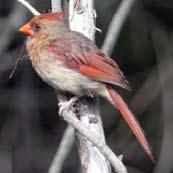 by Andy Wood
by Andy Wood
This past February 13th through the 16th, people across the country turned out to participate in an annual citizen science project called the Great Backyard Bird Count.
Now in its 12th year, the Great Backyard Bird Count (GBBC) is a joint venture of the National Audubon Society and the Cornell Lab of Ornithology, along with thousands of volunteers from across the country, all focused on one thing: looking for and counting the birds of winter. While a fun activity, this effort provides an opportunity for many people to engage in a scientific endeavor designed to increase our understanding of bird populations across North America.
I look forward to this event because people of all bird-watching skills can contribute their knowledge to scientists studying our winter birds’ winter ranges and population numbers. Count participants need not search for rare and obscure birds, but rather, just take a little time during one or more of the four count-days to observe and log the birds seen, whether in a park, a backyard feeder, or maybe some remote birding destination.
The only real catch to this effort is that it’s an internet-based program. By that I mean, participants have to go to the Great Backyard Bird Count web site (www. birdcount.org) and enter observations on the supplied bird checklist. I admit to being only marginally computer literate, as my colleagues will all attest, and yet even I can navigate the process with ease.
What we need from participants to make this project work is at least 15 minutes of continuous bird observation from as many spots as you want to collect data.
In 2009, Great Backyard Bird Count (GBBC) participants sent in record numbers of checklists for the fifth year in a row. As of March 15, counters across North America had submitted 93,629 checklists reporting 11,550,200 individual birds of 619 species. This represents a 9% increase in checklist submissions over last year, as well as a new high for numbers of individual birds counted.
The important rule here is to count the greatest number of birds of each species seen at one time. In other words, if you are watching a feeding station and a lone cardinal arrives, you log one cardinal. If it leaves and moments later two cardinals arrive, you cross out the first one and log two birds as the greatest number seen at one time; If you see three cardinals at once, cross out the previous two and enter three, and so-on. This way the same birds are not counted twice. And if you are not sure about what kind of bird you saw, either don’t include it, or make note that you are not sure and the count tabulators may contact you to try and verify its identity.
I can attest to this because I live in a long leaf pine ecosystem that supports rare and seldom reported birds that I have opportunity to include on my list, which is always questioned by the scientists collecting the information. In my case, when I include something as rare as the federally endangered Red-cockaded woodpecker on my backyard list, the assumption back in the Lab is that I misidentified a more common species such as a downy or hairy woodpecker. When I received a confirmation call last year I tried not to sound like I was bragging when I told the person on the other line that, yes indeed, I saw this wicked cool bird in my own yard, along with brown-headed nuthatches, pine warblers and other pine forest bird species. This verification effort is part of a fail safe system that assures the GBBC data is good.
Of course, I include on my list the more common mourning doves, bluebirds, juncos, goldfinches, titmice and other feeder-visiting birds, and these accounts help build an image of southeastern North Carolina’s wintertime bird populations. When combined with volunteer-collected bird data from across the country, a continental snapshot picture reveals where the birds are in winter; information that helps chart range changes and cyclic events as when birds from northern climes are seen in numbers far to the south. And as you might expect, the GBBC and other projects help track southern birds as they
expand their range northward, possibly in response to climate change. In 2008 more than 85,000 GBBC checklists were submitted containing valuable data that logged
nearly ten million birds representing 635 species. This amount of data far and away exceeds anything professional scientists alone could gather in such a short period of time.
The GBBC is one of several similar research projects involving a wide array of people with diverse interests and knowledge levels about birds, other wildlife, and plants as well. The longest running “volunteer scientist” program is Audubon’s Christmas Bird Count (CBC); an activity begun 109 years ago and this past year resulted in 2,048 reports by bird watchers who observed 65,350,860 birds around the world, in almost all kinds of weather. The wealth of CBC data collected largely by volunteer birders has proved valuable and has been used by researchers working to reverse declining trends in many once common birds.
So, just when you thought science was only for scientists, the Great Backyard Bird Count and other volunteer-based science endeavors offers an opportunity for anyone willing to participate in the research that goes into bird conservation. So, next February, log onto www.birdcount.org, help us count the birds, and in so doing, connect yourself with nature, outdoors.
Andy Wood is Education Director of Audubon North Carolina, and is the author of Backyard Carolina. Proceeds from the book support Andy’s work to protect two critically endangered species of freshwater snails, both endemic to southeast NC. His commentaries can be heard every other Monday on WHQR.
Progressive Gardens— Everybody’s Gardening Store
by Valerie RobertsonEvan Folds must be doing something right: for the second time in six years he’s expanded his store into bigger quarters.
Evan didn’t start out to have a neighborhood gardening store. When he first opened Progressive Gardens in 2002, it was geared primarily for hydroponic gardening. Hydroponics, the science of growing not in soil but in nutrient-enriched water, is especially suited for indoor growing in tight spaces. “I assumed that in an urban area, we’d be needing to grow our own food, and in an urban area the
only place to do it is up.” But the business has evolved into a resource for supplies and advice for any gardener interested in producing vigorous and nutritional results.
Even while tucked away from driveby traffic, the store grew. Evan started marketing to a broader audience. From the beginning, a hallmark of his business was education. With degrees in biology and ecology from UNCW, Evan is able to make any visit to Progressive Garden tantamount to a biology lesson. He won’t tell you how to grow things as much as teach you how things grow best.
It’s all about healing the soil.
Evans explains. “Instead of relying on individual pesticides or herbicides designed to target and eradicate ‘problem’ plants and insects, use their presence to indicate what the soil needs.” His products and services are tailored to bring the soil back into balance. “Don’t feed just the plant, feed the biological and ecological system in which it lives, and the result will be healthier plants growing in a nontoxic environment that’s safe for people and pets.”
This natural approach may take longer to establish, but instead of fighting unde -
Herbalism Classes Starting
An Herbalism class series will be held at the Community Action Center from 6:30-8:00 pm from May 26 through July 28. There is a recommended donation of $10 per class. Barter is also accepted. The first class of the series will cover (with hands-on demonstrations) how to make infusions, tinctures, vinegar, oils and salves. More information is available at the Web site: www.meetup. com/wilmington-herbalists. Please contact kathryn sisler with any questions at 908.670.1590 or kathryn.sisler@gmail.com.
May 26 - Basic Herbal Preparations
June 2 - Plant ID and Harvesting
June 16 - Fermentation
June 23 - Guest Speaker
June 30 - Herbal Sun Care and Herbal First Aid Kit
July 7 - Calm, Cool and Relaxed - Herbs for stress, anxiety and emotional well-being
July 21 - Women’s Alternative Health - Part 1
July 28 - Women’s Alternative Health - Part 2
sirable plants and pests—often a losing and increasingly toxic battle—it nurtures the biological balance that will allow beneficial plants to flourish. The benefits can be enormous for those willing to give it a try.
The principles are not new: the concept of biodynamic farming grew largely from a series of lectures given by Austrian scientist Rudolf Steiner in 1924. Evans recommends Secrets of the Soil:
Evan Folds designed the Vortex Brewer as a way to make actively aerated living compost tea solutions. Microorganisms thrive and re-populate by the trillions when premium compost is given a source of oxygen and food.
Evan based his invention on the vortex, because Nature does not work in symmetry and straight lines, but ordered chaos, or, the double cycloid spiral curve of a vortex. A vortex is life, energy, and creation.
Progressive Gardens continues to brew its own compost tea in the store for customers who drop by and want to take a gallon home. Bring your own jug! The tea is free, and so is the explanation of how it works.
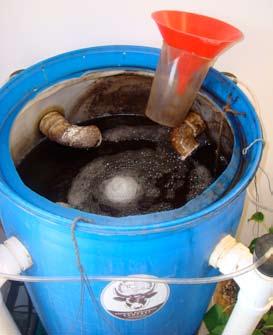
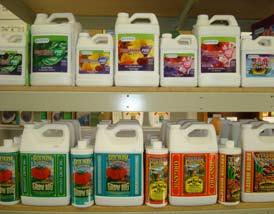
featured business - Progressive Gardens
(continued from page 8)
Progressive Gardens is one of four businesses this busy entrepreneur is juggling. Evan invented a compost tea system, the Vortex Brewer, that can be manufactured in sizes to suit any scale operation, from residential to large farm.
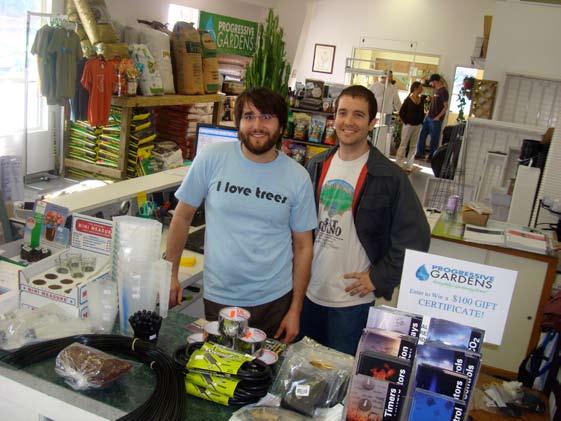
Progress Earth, his wholesale distribution company, includes a division geared toward helping farmers transition from common to more organic farming practices.
The newest company, A Natural Approach, provides 100% organic land care including custom-designed living solutions for any yard “problem.” A Natural Approach offers a chance for him to help clients implement in their own yards the life-sustaining principles he espouses in the store.
At a recent presentation before the Cape Fear Green Building Alliance, Evan offered suggestions for ways different professionals can promote more healthful living. For architects, why not suggest a client incorporate an indoor grow room into their living space? He encourages contractors to advertise if they offer drought-tolerant, lowmaintenance landscaping. To homeowners’ associations he advises cutting back or omitting toxic spraying and to consider encouraging community composting and garden space.
Progressive Gardens is now located at 6005 Oleander Drive, Wilmington. (910)3951156. Come by any time, for information, the latest in gardening ideas, and for a greater appreciation of the science behind why the natural approach is the way to go.
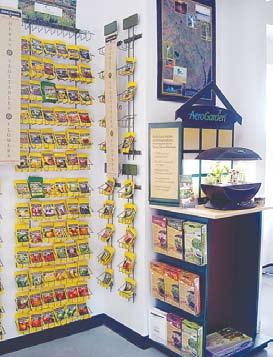
Organic seeds are available for those who don’t want the waiting time of ordering from a catalog.
New Solutions for Restoring Our Planet,
by Peter Tompkins and Christopher Bird, as a useful modern text in what he describes as his “small but profound” book department.
From the very beginning, Evan has believed in the value of education, and trains all staff to believe this, too. Progressive Gardens’ employees embrace his holistic approach to gardening: promotion of the healthy rather than suppression of the unhealthy.
“It’s all about relationships,” says Randall Shapiro, who joined Evan’s team early on. All the staff who work with Evan are trained in the biology of what they’re doing, and each is encouraged to spend time educating their customers about the principles behind what they offer. It’s clear they are concerned not just with the interplay of soil microorganisms but with developing ongoing relationships with their customers.
Evan notes that as his customers have become more attuned to the nutritional barrenness of many of our commonlyavailable foods, they are more likely to walk into his store already sold on the idea of building soil health. “They come in knowing about and asking for compost tea.”
The new space on Oleander offers enough room for Evan to consolidate all his businesses under one roof, cutting back on his travel time. The open, sunny store has room for plants as well as classroom space. Workshops on natural landscaping are common on Saturdays.
To keep abreast of Evan’s projects, visit his four company Web sites:
featured flora
Dwarf
Palmetto “Small” on stature, big on attributes
by Alistair GlenWhen venturing through local woodlands and waterways in search of native plants, every now and then I come across a plant that doesn’t seem to quite fit in among the oaks, pines, maples, and other species so typical of our region. One such plant I run into from time to time is dwarf palmetto, a shrubby palm that is sometimes encountered in large colonies, growing as an understory in swampy woods where it lends a rather prehistoric feel to the forest. In such settings, I always feel I would not be surprised if a dinosaur came crashing through the trees! Fortunately this has never happened, yet.
Among palms, dwarf palmetto has the honor of having the most northern distribution of any New World palm, extending in the wild from Texas, along the Gulf Coast to Florida, and up the East Coast as far north as Dare County, North Carolina. In North Carolina, dwarf palmetto is considered an uncommon native plant and is mainly found in our coastal counties, growing in maritime forests, low woodlands, and areas bordering rivers and streams. Though not always, they often grow where there are deposits of shell limestone under the soil. One of the most
visible places to see dwarf palmetto in our area is along Interstate 40, just south of the Rocky Point (408) exit. Here, large colonies cover the ground, creating a sea of green under the canopies of oak, hickory, and maple trees. They are most noticeable during fall and winter when the other trees, shrubs, and vines that grow in this unique woodland have lost their leaves. Dwarf palmetto can also be seen up close, and without the worry of being run over on the Interstate, at Carolina Beach State Park, along the Intracoastal Waterway, and on the banks of the Cape Fear River and its tributaries.
I love to see dwarf palmetto planted in the landscape, where it makes a striking addition and is very tough and adaptable. The large, fan shaped leaves of this evergreen palm may measure five feet or more across, while the whole plant, which grows like a shrub, generally ranges between five and seven feet tall and wide. Like other palms, dwarf palmetto does form a trunk, but it grows underground it grows more quickly, adding several new leaves each year.
Dwarf palmetto (sabal minor) makes a dramatic and low maintenance addition to any garden; mature specimens reach 5-7 feet and require little water once established.
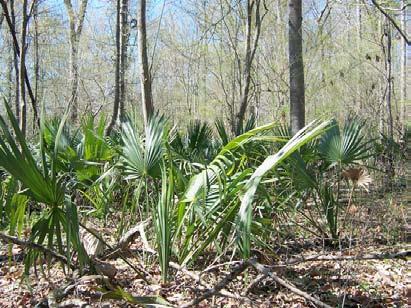
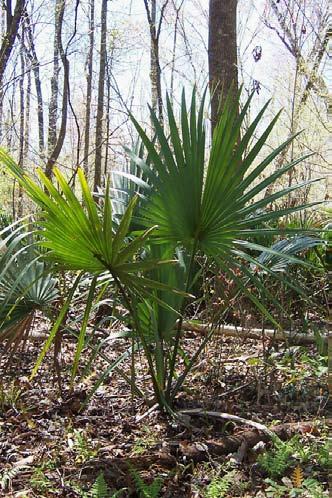
rather than upward. This underground trunk can grow as deep as three feet or more, making dwarf palmetto very difficult to transplant once it is established – take it from someone who has tried! When planted, dwarf palmetto spends its first couple of years putting most of its energy into growing roots, so it is initially a slow grower. Once established though,
In the landscape, dwarf palmetto prefers moist soil and can tolerate short term flooding, making it a good choice for rain gardens. It is also surprisingly drought tolerant and will grow in all but the driest soils if care is taken to keep it watered during the first couple of growing seasons while becoming established. Dwarf palmetto prefers to grow in part shade, but can be grown in deep shade as well as full sun and, like all palms, is very resistant to deer browsing. This tough and adaptable palm also tolerates salt spray, making it ideal for gardens close to beach.
I like to incorporate dwarf palmetto into the design of the garden in several ways. In areas with limited space, this
(continued on page 11)
dwarf palmetto
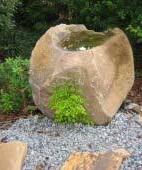
continued from page 10

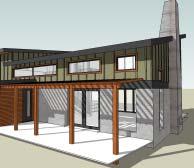
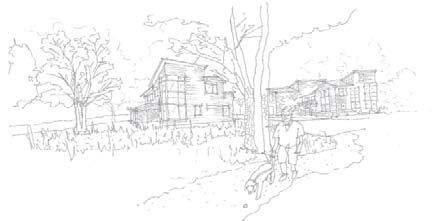
shrubby palm makes a dramatic specimen or focal point with its bold, evergreen foliage and strong architectural form. One of my favorite ways to use this plant is by mimicking nature and planting dwarf palmetto in large groups under the shade of deciduous trees, where it creates a beautiful and enchanting effect. It can even be used as a low hedge, where it makes a striking backdrop for other plants.
For wildlife, dwarf palmetto’s greatest asset is its evergreen leaves, which provide year round cover for all types for animals. Masses of tiny white flowers blossom on long spikes up to seven feet tall in late spring, attracting a variety of insect pollinators. The flowers are followed in summer by green pea sized fruit that ripen and turn black in late summer and fall and serve as a valuable food source for migrating birds.
Overall, dwarf palmetto is a hardy and adaptable plant that should be grown more often in area landscapes for both its beauty and toughness. Wherever it is found, in the wild or planted in landscapes, this dramatic small palm creates a vibe that is partly tropical, partly primeval, and is always eye catching. For me, whether it is grown in gardens or viewed and appreciated in the wild, dwarf palmetto will always be one of the many plants unique and special to our small corner of the world.

Alistair Glen is owner of Growing Wild Nursery, which specializes in nursery-propagated native plants of the Atlantic coastal plain. Learn more about plants native to our area at: www. growingwildnursery.net.


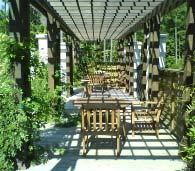
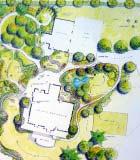
April 22 marks the 40th Earth Day celebration. Wilmington will celebrate the event with a festival in Hugh MacRae Park April 18, from noon to 6 p.m.
Bring your family and friends to this free event and enjoy food, beverage, live entertainment, a Kids’ EcoZone, and even shopping in the Green Market — all to celebrate our planet and raise awareness.
The weather will be fine, so consider coming by bike, or by foot, or by electric scooter... come show everyone how you get around.
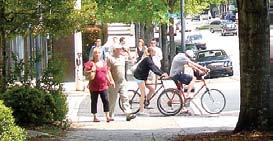
Printing costs for this special Earth Day issue underwritten by The Boreal Explorer, of Willow, Alaska.
Earth Day Alliance: Wilmington’s Contribution
The Earth Day Alliance is a non-profit organization consistingly primarily of county Earth Day Alliance and city employees from various departments. Participation with the Alliance is on a completely volunteer basis and is in addition to each member’s regular work duties.

The sole purpose of the Alliance is to organize and arrange each year’s Earth Day Festival at Hugh MacRae Park. All money raised goes directly toward ensuring the success of the following year’s event.
Let Us Know How YOU Get Around
on foot
sailboat
surfboard
bicycle
tricycle
motorized
scooter
foot-powered
scooter
Segway
Send us a picture of how YOU get around, and we’ll publish as many as room permits in the summer issue of Going Green. We want to show a wide variety of traditional to nontraditional ways of getting around, so show us what you do!
bus car
trolley truck
hybrid
biodiesel
horse & buggy
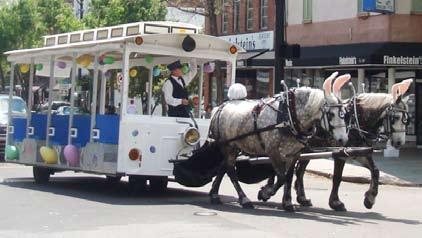
horse, no buggy
llama
wheelchair
sailing ship
pogo stick
stilts
roller skates
wagon parent
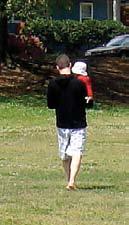
Earth Day 2009:
Earth Day was created in 1970 to promote environmental awareness and to encourage progressive action around the world. It is officially celebrated every year on April 22, although individual communities around the world and in our region host celebrations throughout the month of April. These festivals are just one way we celebrate the Earth and renew our commitment to building a greener, healthier, more sustainable planet.
Area events:
April 11 – Live Green Music & Arts Festival – Bolivia
April 18 – 2nd Annual UNCW Environmental Film Festival 12 - 5p
April 22 – Build a Rain Garden with Cape Fear River Watch
April 22 – Sustainability Fair at UNCW 11a - 2p with concert on the Commons

April 22 – Earth Day Open House Sapona Green Building Center 4 - 7p
April 25 – Big Greenfield Lake Clean-Up 9a
Earth Day 2008:
Folks celebrated Earth Day 2008 with a festival in Hugh MacRae Park. As evidenced by performer Mark Herbert, the local 2008 theme was “trees please.”
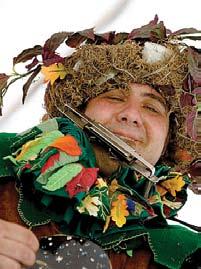
Organizations hosting these events are listed starting on page 20. Details are available at www.goinggreenpublications.com
Life in Trolldom
Please recycle this magazine. Better yet, pass it along to a friend!
green building
A Golden Opportunity—
by Scott OgdenMonteith Construction LEEDs the Way
Before our love affair with the automobile and all things larger and newer, humans were quite adept at recycling, as a look at the history of 32 No. Front Street reveals.
Local historians disagree on the exact date but set the building’s construction around 1870. Newspaper accounts list a dizzying succession of tenants since, from a shoe factory to a tailor shop to a bookseller and stationers to a clothing store before finally being abandoned. Monteith Construction’s environmentally-friendly remodeling techniques are well-documented. But the decision to remodel an existing downtown building, especially in a thoughtful manner, might be the greenest decision of them all.
Although fairly new to the Wilmington area, Monteith Construction is LEEDing the way when it comes to sustainable development. The company was recently presented a 2008 Outstanding Achievement Award from the Lower Cape Fear Stewardship Development Award Program (LCFSDAP) at their fourth annual ceremony at UNCW in November. This latest award caps the company’s commitment to sustainable building practices.
Monteith Construction’s new corporate headquarters at 32 No. Front Street had already netted a prestigious LEED Gold Certification, the first LEED award in Wilmington. The U.S. Green Building Council, in an effort to encourage environmentallyand worker-friendly building, has developed a set of standards to indicate how “green“ a building or renovation is. Following these Leadership in Energy & Environmental Design (better known as “LEED,” see sidebar for details) guidelines can earn a building LEED certification. In their jury comments, one of the LCFSDP judges stated that “this project demonstrates all aspects of green building…and it exemplifies the Stewardship program.”
Older buildings can present design and sustainability challenges. In this case, according to owner John Monteith, the building’s age and history created a series of opportunities instead. The company was leasing space and wanted to make a more permanent home in Southeastern North Carolina. Monteith could have pursued a suburban location but decided to recycle an existing downtown building; as he stated at the stewardship dinner, “the most green thing we did was to decide to locate downtown.”
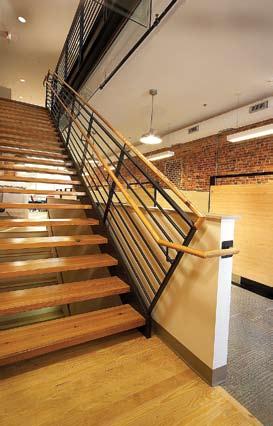
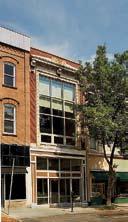
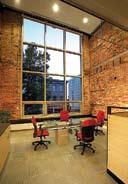

Inside, the renovation is impressive. Lackluster 1950s alterations had partly obscured the windows and left the building dark and formless. Knocking out part of the third-level floor opened up the space and allowed light to fall throughout the building. Much of the wood from this area was recycled into stair treads (also open to allow more daylight), handrails and other trim. The open-concept workstations feature bamboo panels and recycled doors stacked on concrete blocks as desktops.
All three levels are bathed in daylight and offer views of downtown street life.
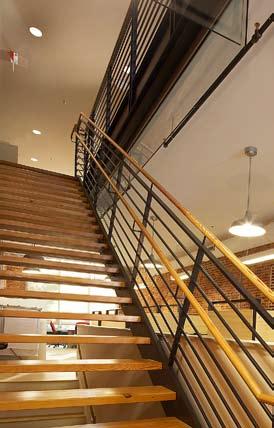
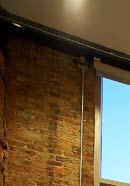
What’s a LEED?
By Scott OgdenFor anyone who’s not yet heard of it- LEED is the most recognized and developed voluntary system of quantifying the performance of a “green” or high-performance building. The benchmark acronym stands for Leadership in Energy & Environmental Design. It was created by the United States Green Building Council (USGBC) in 1999 as a national and global sustainable practices model. The rating criteria have evolved through several versions over the last decade; the newest version is LEED 2009 (with a new point system ranging up to 100 points.) The system encourages green building practices and promotes a systems or whole-building approach to development and construction.
There are six main categories for obtaining points in LEED: sustainable sites (SS), water efficiency (WE), energy & atmosphere (EA), material & resources (MR), indoor environmental quality (EQ), & innovation & design (ID). All areas can gain between 5 & 13 points towards a certification level with a maximum total of 69. Projects are given a ranking with the highest being Platinum (52-69 points) followed by Gold (39-51) Silver (33-38) and Certified (26-32.)
photos this article by Melva Calder
www.melvacalderphotography.comThe decrepit three-story shell he purchased in 2007 on Front Street in downtown Wilmington had gone through a series of unfortunate renovations that compromised much of its original nineteenth-century character. Garrett Theisen, head designer with the architectural firm LS3P, led Monteith’s team through the rigorous Wilmington historic preservation review process and restored the storefront to its 1914 Shrier version, the best documented available. The result: a building that retains its 1914 flavor yet looks timeless.
From its simple beginnings in 1999, the growth of the USGBC and LEED have been enormous. There are currently 1,540 certified LEED projects and over 13,000 projects registered for the program. Accredited professionals, or LEED APs, have now surpassed 65,000 and USGBC professional membership is over 18,000. LEED certification has been confined to commercial sites, but there is a similar project in the works for residential units. For more information, visit the USGBC’s website at: http://www.usgbc.org/
green building
Monteith Construction LEEDs the Way
The only closed areas are the restrooms, equipped with low flow fixtures and a shower/locker area, and a conference area, which is constructed of clear glass on two sides.
The main level is a contemporary spin on a historic storefront with a modern, bright red monolith for their cubic “M” logo, cork floors (a rapidly renewable material), and a tin ceiling which makes use of recycled metal while reflecting light deep into the building.

The construction team used numerous green building measures to increase energy efficiency. The space is heated and cooled by an innovative Daikin VRF (variable-refrigerant-flow) system which is extremely quiet, compact, and can heat/cool/dehumidify multiple zones for maximum savings and comfort. The roof is also coated in a highly reflective membrane which reduces heat gain and the urban “heat island” effect, while the two-story window in front is tempered with an automated interior solar shade system.
The building, with its variable-flush toilets and low-flow faucets and showerheads,
uses 40% less water than a similarly-sized conventional building. And the showers aren’t gratuitous: in concert with bike racks, they encourage commuting without a car, as Mr. Monteith does on most days. Both the envelope and systems meet the ASHRAE Advanced Energy Design Guide for Small Office Buildings 2004, performing above code by at least 30%. Additionally, Monteith purchases 70% of their power from Renewable Choice Energy, a Green-e certified clean source energy provider. (See www. green-e.org.)
All interior finishes are no or low-VOC and include 40% recycled content. Carpet tiles, cork flooring, bamboo panels, and other surface materials meet high environmental & IAQ (indoor air quality) standards. Employees can control ventilation and task-lighting at each workstation, and motion-sensors turn light off automatically when an area is not being used. The team also developed a waste reduction and recycling program that allowed Monteith to either reuse or recycle over 80% of the nontoxic construction debris.
Working on its own headquarters project has helped Monteith Construction meet its other local projects’ sustainability goals, including an anticipated LEED certification for the new Lower Cape Fear Hospice building as well as the River Lights development for Newland Communities on River Road. However, the biggest return may be the satisfaction of his employees and staff. Says Monteith: “It’s a great place to work, there’s a great energy and vibe, everyone in our company loves to be down there.” If you see him biking on the way to work, give him a thumbs up for leading the “greening” movement of recycling older buildings downtown into efficient work environments as well as infill that gives back to the urban fabric of downtown Wilmington.
Scott Ogden, AIA is an architect who practices in downtown Wilmington and in 2005 cofounded the B & O design studio, pllc. He is the 2009 President of the AIA/Wilmington Section, former board member of the Cape Fear Green Building Alliance (CFGBA), and a member of USGBC.
Monteith Construction, Corp. is a construction company with offices in Wilmington and Charlotte locations. They build commercial, institutional and medical projects and have several LEED projects in their portfolio. Owner & Wilmington office head, John Monteith, relocated to the Cape Fear area to head up the Wilmington office’s operations and manage their new growth here. They are currently completing the Lower Cape Fear Hospice expansion, which received a Significant Achievement award from the LCFSDAP in 2007. Learn more about them at www. monteithco.com.
Alternative Fuel Car Show Comes to Wilmington
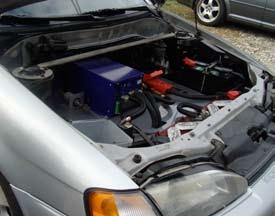
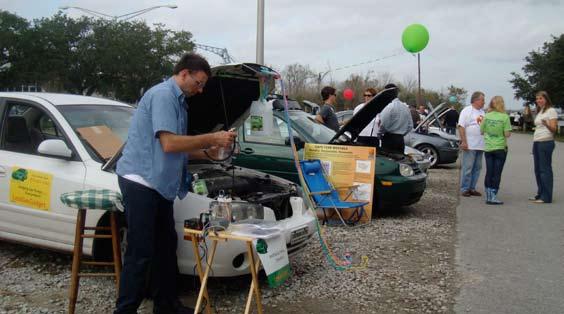
When Ashley High School senior Katie Mallard needed a senior project, she organized a Wilmington first: an event showcasing different approaches to fueling our vehicles. Four hundred people showed up.
by Katie MallardIf you could make a difference in the world and help better the environment, would you? Although environmentally friendly options are becoming more and more popular, many are still unaware of the alternatives that are available. To help educate and inform the community, I decided to organize an alternative fuel car show. It was probably one of the best things that could have happened to me. The people I met, knowledge that was shared, and the overall accomplishment of the event has only solidified the direction in which I hope to live my life.
As a senior at Ashley High School, I am required to complete the Senior Graduation Project. Many local businesses and organizations know about this program, and frequently aid the seniors in any way possible. Recognizing this, I decided to take advantage of the opportunity I had been given.
Coordinating the car show turned out to be a very difficult process. Many organizations such as Cape Fear’s Going Green, Cape Fear Biofuels, Natural Awakenings, and the local newspapers all pitched in. Together they helped me gather the contacts needed to find alternative fuel cars, they donated advertisement, and all of them gave me non-stop support. I was
awed at the encouragement I received from each and every one of them. On the other hand, others in the community were pessimistic about my efforts. With a few exceptions, the car dealerships and some of the more wide-spread businesses wanted no part in the show. I was told that two months was not enough time, and I would not be successful. While this was tough to hear, it motivated me even more to make the show a guaranteed success.
As the show approached, the pieces started to come together. I had gathered a number of alternative fuel cars, secured places for volunteers to set up information booths, booked a number of bands for the day, and established a vender for food. At this point, I was extremely pleased with all that was donated to me, especially the bands. Four bands, The Cedar Circuit, The Harbor, Chad Haithcock, and Ponchos from Peru, all donated their time and music for free.
The day of the event could not have been better. We had around twenty alternative fuel cars showcased, with fuels such as waste vegetable oil, biodiesel, electricity, and hydrogen. Most were owned privately; however, the Saturn and Jeep dealerships, as well as Bleecker automotive, also brought out vehicles. All
Biofuel enthusiast Matt Collogan had long wished for an auto he could run exclusively on locally-produced biodiesel. His dream came true in November, and the maiden voyage of his newlypurchased 1985 Mercedes-Benz was a drive to the Alternative Fuel Car Show. His “B100” license plate is a reference to the 100% biodiesel fuel mix he uses. In colder climates, because pure biodiesel congeals at temperatures of 30 o F or higher, depending on the source of the oil used to make the biofuel, some opt for a different mix: B85 indicates a mix of 85% biodiesel and 15% regular diesel.
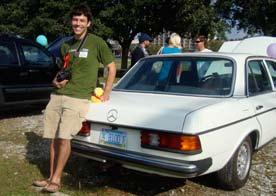
transportation

of the owners were available to talk to, and discuss how owning an alternative fuel car has changed their life. Cape Fear’s Going Green Publication and Cape Fear Green Building Alliance set up tents in order to spread ideas on ways to better the environment.
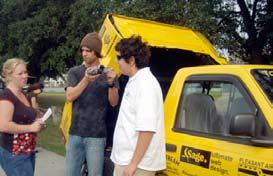
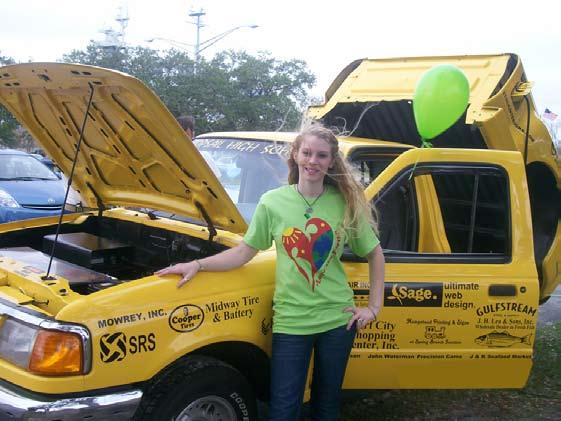
Overall, the car show was a huge success. Participants came from as far away as Fayetteville to show their vehicles, and four hundred people showed up to look at them. My goal was to inform the public that there are alternatives to gasoline—ones that do not have to bust your wallet and drastically change your lifestyle. I believe I accomplished this. I was amazed at the number of people who had no idea about some of the existing options. The greatest part of my day was being at the show and seeing how fascinated everyone was; not to mention how much they were learning that was not known before. Knowing that I made a difference was possibly the best feeling in the world.
Katie Mallard hopes to transform her love for the environment into a lifelong pursuit. “Nothing would make me happier,” says Mallard.
Watch the Car Show Documentary on YouTube
by Christina SimonWith huge grins on our faces, we sat in an electric car for the first time. Josh slowly and expectantly turned the key in the ignition and… Nothing happened. Hunh. He tried again, with the same results. We sat there, a little sheepishly, until it dawned on us that the car was indeed turned on, it just neither vibrated nor made an audible sound as we had expected.
This is how we spent our whole time at the Alternative Fuel Car Show. Wonderingly taking in the information, slowly grasping the complexity and importance of the topic, and quickly becoming engrossed by it.
Fact is, this car show broadened our horizon. We did not know half of what the car owners patiently explained to us. Check out youtube.com for the three-minute documentary we made in an attempt
to share this knowledge with the world: “Alternative Fuel—An Introduction,” created by Christina Simon, Josh Prindiville, Cassandra Kollmer, and Jonathan Ware for the Introduction to Film Production class at UNCW, taught by Chip Hackler. Christina Simon is a film studies major at UNCW. The documentary can be seen at http://www.youtube. com/watch?v=JcK8-g3cZo8.
Asked to make a three-minute documentary, a group of film students chose to cover the Car Show. Director Christina Simon describes the experience of test-driving an electric truck.Film studies students Simon and Prindiville capture information for their documentary. Josh Prindiville and Christina Simon try a Zenn truck, which can travel 40-45 miles on one charge and was brought to the show by Bleecker Electric Car Company. Learn about electric vehicles available from Bleecker at www.bleeckersuperstore.com.
business news
Rain Garden Certification Class
A new Residential Rain Garden certification class is now being offered; the inaugural class was held March 4, 2009 at the Arboretum. The certification is geared toward the landscape community but all are welcome. Registration costs $125, and covers how to design, install and maintain a home rain garden. Registration is through NC State’s Biological and Agriculture Engineering (BAE) Department.
For information or to learn about the next class, please contact Nicole Mitchell at (910)512-9352 or nicole_mitchell@ncsu. edu.
New Positions
Lisa Manning, PE, LEED AP, has taken a new position with Altamont Environmental, Inc., an engineering and hydrogeology company located in Asheville, NC. She will work as an environmental engineer on a variety of projects including, but not limited to stormwater, sustainability, remediation, groundwater monitoring, and stream restoration and design projects. Altamont’s mission is to protect, conserve, and restore the quality of our natural environment with a particular focus on water - the earth’s most valuable resource. www.altamontenvironmental.com.”
New Community Supported Agriculture (CSA)
If you wanted to participate in Community Supported Agriculture (CSAs) this year but didn’t sign up in time, take heart! More CSAs are coming to our area! Community Supported Agriculture is a food delivery system whereby the customer prepays a farmer for a season of food; weekly distributions of fresh produce or other food are then delivered weekly to a central meeting point for customer pickup.
Progressive Gardens
Cottle Organic Farm in Rose Hill, NC will offer ten weeks of local and organic food for a subscription of $250, starting mid April. Pick-up will be Wednesdays at Progressive Gardens. Call (910)395-1156.
Veggies by the Sea
Sybil Mitchel Simmons writes that Veggies by the Sea is now accepting CSA subscriptions as well as buyer’s club subscriptions. Email veggiesbythesea@yahoo.com or leave a message at (910)754-8998.
commuting
Take the “Cape Fear Commutes” Survey
What are Wilmington’s transportation needs? We are in the midst of a federallymandated assessment of the current and future transportation needs of people and goods within the Wilmington Metropolitan Planning Organization area. Cape Fear Commutes will create a plan with recommendations regarding how those needs should be addressed over the next 25 years. Your input is needed! Please take the Cape Fear Commutes survey at: www. capefearcommutes.org.
Commuter Challenge Players Realize Savings
CopperGuinea Farm
Neal Young has partnered with Molly and Charles Rousey to start a CSA project at their place in Atkinson, CopperGuinea Farm. They grow a wide variety of sustainably produced vegetables, eggs, honey, fresh bread, and other items. Partnering with several other growers lets them include cut flowers, poultry, and fresh herbs. They offer both a traditional CSA subscription model and an on-going availability list. Each of the 10 CSA subscriptions provides enough veggies for a family of four for 12 weeks: April 15-July 15. In addition, they have an on-going availability list of offerings from several farmers that will be emailed to interested folks once a week. That list will normally include vegetables, fruits, frozen poultry, eggs, honey, bread, cut flowers, herbs, and other seasonal offerings. The plan is for it to serve the Wilmington area, but if someone is willing to drive to the farm to pick up, they can come from anywhere. The cut-off for the 10-member CSA was April 1, but the ongoing list should be open at least through July 15, on a first-come first-served basis. Contact Neal Taylor at oneworlddesign@ec.rr.com or (910) 470-1030.
or NancyNajarian@gmail.com
Starting a CSA? Send us your news! Editor@ goinggreenpublications.com.
Eleven employer teams participated in the 2nd Annual Cape Fear Breeze Commuter Challenge last fall. Experimenting with creative ways to get to work for a period of four weeks, they realizing financial savings while learning about earth-friendly ways to get to work.
The Challenge is a contest encouraging employers, employees and the general public to take advantage of alternate methods of transportation. Building on the success of the inaugural event when almost 3500 alternative transportation trips were made by members of seven teams, the Employer Group met its 2008 goals to increase the number of employer teams participating and to encourage use of alternative transportation beyond the Challenge period.
A total of 31,895 miles were travelled by carpooling, scooting, walking, riding the bus, and biking. This commuting shift saved almost 1000 pounds in carbon monoxide, 160 pounds in NOx (the particularly nasty pollutant that contributes to the formation of acid rain, ground-level ozone, decreased water quality, and global warming), and 130 pounds in volatile organic compound pollutants not emitted into the atmosphere. For more information about ways Cape Fear Breeze can help you, contact Lawless Bean, Special Assistant to the City Manager & Cape Fear Breeze Program Coordinator, at (910)341-4665 or lawless.bean@wilmingtonnc.gov. You can also visit www.capefearbreeze.com.
make every day earth day
Things You Can Do All Year Round! Resources to Help you Get There
Earth Day festivals and activities are a great reminder to celebrate earth and our connection it. But why not make every day Earth Day? There are many ways to get involved: joining a local environmental group can help you meet people, get outside and have fun, and make a difference. Or why not attend one of the many area activities devoted to our environment? Our online calendar includes a variety of activities for all ages and interests.
Most important, consider the changes you might be willing to make to save the world. Even a small act can make a big difference. What might you be willing to do? Below are some ideas from the editors of Cape Fear’s Going Green to get you started.
How to make Earth Day every day
Minimize toxins in your home and environment:
Read labels carefully and replace toxic chemicals with natural products
Hire a “green” cleaning service
Plant native species that are naturally drought- tolerant and pest-resistant
Maintaining a lawn is expensive and difficult, consider less lawn and more non-lawn
Recycle electronic items (cell phones, computers, tvs) appropriately
Use a stainless steel water bottle instead of plastic
“B” is for Biofuels...
In your community:
Talk to your child’s school about the benefits of natural lighting and less-toxic materials
Organize a recycling day for electronic items or block Styrofoam
Share tools, seeds and gardening tips with your neighbors
Eating sustainably
Think about where your food comes from Grown your own if possible
Talk to your kids about what we eat and how it nourishes us
Make conservation a habit
Take your own containers to the store when buying bulk items
Find fun close to home
At work:
Use recycled paper and plastics
Install motion sensors for lights so offices and restrooms are only lit when in use
Discuss conservation with your employees
When you have green programs in place, publicize it: it can only help your business
Save money by going green
Remodel “green” wherever possible: salvage what you can, use low-toxic materials. —Think efficient, not big
Pack your lunch
Nourish the earth
Put up a bathouse, or a beehouse, or both. Get the kids involved
Plant a tree
Make a compost pile
Not sure what a term means? Going Green offers an online Glossary of Green Terms. Check the “Tips & Resources” page of www.goinggreenpublications.com to learn what some of these terms mean. We list a few samples below, taken from the “C” section of the list. And be sure to let us know if there’s a term we should add! Sample terms:
Carbon trading
Carbon trading is a way of reducing carbon emissions. Many companies are now part of a carbon trading scheme where the government gives each company a set amount of carbon credits each year. If a company doesn’t use all of their credits, they can sell them to other companies who have used all of theirs.

Climate change
Over the years our climate has changed. Climate change can be due to natural causes, but most scientists agree that the rises in the
Attend an event
Our area boasts a variety of activities for all ages and interests: birding trips, films and lectures, certification classes in rain gardens or LEED building, tours of organic farms. A few sample activities appear below, to get you started. You can always find the calendar at www.goinggreenpublications. com/calendar.html.
April 25
Big Greenfield Lake Clean-up. Ashore and afloat. On the lake and up the creeks. Come help clean up Wilmington’s secret gem. Cape Fear River Watch provides: tools, gloves, bags, boats, snacks and drinks. Meet at Greenfield Lake Boat House at 9:00am or contact Bill Murray (wmurray@cfrw.us) for more information.
May 2
Cape Fear River Watch offers a free educational seminar at 9 a.m. the first Saturday of each month, at their headquarters at 617 Surry Street, downtown Wilmington. In May, Sera Harold Drevenak will speak on the state of North Carolina’s fisheries, with special emphasis on the fish of the Cape Fear River. Pancakes at 8:30, Seminar at 9. www.cfrw.us.
May 12
Cape Fear Audubon Society Field Trip along riverfront: see pine/hardwood foreast, wetland forest, salt marsh, maritime forest, and shrub. Contact Nancy Buckingham at nsbuck@charter.net or (910)452-7012.
May 29 & 30
Wilmington Hobby Greenhouse Club Summer Plant Sale - two days. Free admission; all plants locally grown. 2318 Metts Avenue, Wilmington, off Forest Hills Drive. email hobbygreenhouseclub@ec.rr.com or call Amy Finelli at (910)398-7603.
Earth’s temperature are linked to the way we live and activities like burning fossil fuels. This means that the temperature of the Earth is getting hotter, causing ice caps to melt and sea levels to rise.
Cradle to cradle
This is a construction and production ethos proposed by Walter R. Stahel that aims to make all components of a made object reusable or disposable with no negative ecological effects– virtually waste free.
Visit www.goinggreenpublications.com
make every day earth day Local Resources
Joining a local environmental organization is a great way to meet people who share your interest in the environment. Use this listing of local environmental organizations to find activities you’ll enjoy while you make every day earth day. Visit our Web site for a more comprehensive list, which includes national resources as well: www.goinggreenpublications.com/tips.html
Airlie Gardens
Historic public garden providing cultural and environmental education. www.airliegardens.org
American Institute of Architects–Wilmington Section
Continuing education seminars to members as well as public outreach to educate the public. www.aianc.org
Audubon North Carolina – Cape Fear Audubon Society
To conserve and restore natural ecosystems within our region, focusing on birds and other wildlife for the benefit of humanity and North Carolina’s biological diversity. www.capefearaudubon.org
Bald Head Island Conservancy
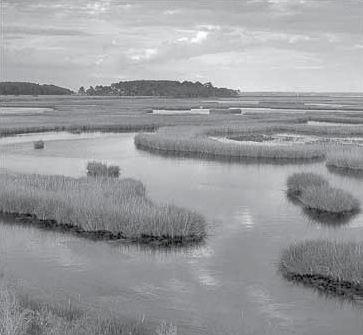
Protects and preserves the natural environment of the Smith Island complex. The Conservancy offers educational programs throughout the year weekly during the summer season to educate visitors about Bald Head Island’s unique environment. www.bhic.org
Brunswick Beekeepers Association
successful beekeeping methods. www.ncbeekeepers.org/chapters.htm
Brunswick Community College
Offers Associate in Applied Science Degrees in horticulture and in aquaculture technology. BCC’s 2+2 agreement with UNCW enables BCC Aquaculture Technology students to transfer aquaculture coursework into UNCW’s B.S. Marine Biology program. www.brunswick.cc.nc.us
Brunswick County Cooperative Extension Office
Information resource for residents of Brunswick County. brunswick.ces.ncsu.edu
Brunswick Electric Membership Cooperative
BEMC is North Carolina’s fastest growing electric cooperative with over 62,000 customers. www.bemc.org
Cape Fear Biofuels
Co-op developing a biofuels infrastructure and related technologies in the region while creating moral, economic, and social value through sustainable development.
www.capefearbiofuels.com
to strengthen landfill regulations in North Carolina.
www.stopthedump.com
Cape Fear Climate Action Network
A local citizen network providing support, advocacy, and recognition for climate action initiatives in the Cape Fear region. www.capefearcan.com
Cape Fear Cyclists
The information hub for Southeastern cyclists! www.capefearcyclists.org
Cape Fear Community College (CFCC) Architectural technology curriculum. www.cfcc.edu/programs/at
Cape Fear Green Building Alliance (CFGBA) Promotes the construction of environmentally responsible, profitable, healthy places to live and work.
www.cfgba.org
Cape Fear Museum of History and Science
Oldest museum in North Carolina tells stories of the region’s history, science and cultures through exhibition and educational programs. www.capefearmuseum.com
Cape Fear Regional Beekeepers Association
Newly-formed chapter of the North Carolina State Beekeepers Association. Receive personal advice from beekeepers in the local community to learn beekeeping and to stay up-to-date on successful beekeeping.
email: methods.gldeagle@bellsouth.net
Wilmington
Established chapter of the North Carolina State Beekeepers Association. Receive personal advice from beekeepers in the local community to learn beekeeping and to stay up-to-date on
What goes in here....
Cape Fear Citizens for a Safe Environment
Spring 2008
Organized to fight the building of Hugo Neu landfill, now encouraging legislation
...ends up here.
Cape Fear River Watch
Environmental education, advocacy and action for the Lower Cape Fear River basin. www.cfrw.us
Carolina Farm Stewardship Foundation
Carolina Farm Stewardship Association’s mission is to promote local and organic agriculture in the Carolinas by inspiring, educating and organizing farmers and consumers. Produces Carolina Guide to Local & Organic Food. www.carolinafarmstewards.org
City of Wilmington Stormwater Services
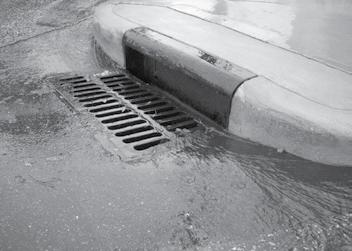
Stormwater pollution flows directly into where we fish, where we swim, and what we drink. Everything that goes into our storm drains - pet waste, fertilizer, pesticides, litter, yard debris, dirt, etc. - makes its way straight to our waterways.
Be part of the solution to stormwater pollution! Learn how: www.wilmingtonnc.gov/publicservices/stormwater
Maintains and improves the City’s stormwater drainage system for the protection of the community and the environment. Provides comprehensive stormwater management that takes into account both the quantity and quality of stormwater runoff. Stormwater education, outreach, and public involvement are important components of this mission.
www.wilmingtonnc.gov
Dogwood Alliance
Nonprofit works to educate people about the importance of forests and the negative envi-
make every day earth day
local resources
continued from page 19
ronmental impacts of business as usual paper production. Having achieved systemic change throughout the paper industry through public campaigns against office super stores--the largest retail paper sellers in the U.S.--they are now addressing protection for Southern forests and forests all over the world. www.dogwoodalliance.org
Earth Day Alliance
Organizers of the Lower Cape Fear Celebration of Earth Day.
www.wilmingtonearthday.com
Electric Vehicle Automobile Association (EVAA) – Coastal Carolinas / Wilmington
Local chapter provides e-mail of current developments and legislation
www.eaaev.org or e-mail: pagepaterson@mac. com
Environment North Carolina
This is a statewide, citizen-based environmental advocacy organization. The professional staff combines independent research, practical ideas and tough-minded advocacy to overcome the opposition of powerful special interests and win real results for North Carolina’s environment.
www.environmentnorthcarolina.org
Friends of Mountains to Sea Trail
The Mountains to Sea Trail (MST) of North Carolina is a 935+ mile trail consisting of footpaths, roads, and state bike routes. Friends of MST’s efforts are underway so that one day a complete foot trail will reach across the state, from the Mountains to the Sea. www.ncmst.org
Full Belly Project
Designs and distributes labor-saving, locally-replicable agricultural devices to relieve hunger and create economic opportunities in developing countries.
www.fullbellyproject.org
Ingram Planetarium
State-of-the-art facility in Sunset Beach seats 85 people in its 40-ft dome theater. Our mission is to stimulate the general public’s interest and understanding of natural science, environment, and cultural history of the coastal region of the Carolinas as well as a broader understanding of our Earth, solar system, and universe by providing quality educational facilities for the public and school students through activities and exhibits.
www.ingramplanetarium.org
Karen Beasley Sea Turtle Rescue and Rehabilitation Center
Dedicated to rescuing sea turtles and educating the public about them. Founder and
Director Jean Beasley is Animal Planet’s Hero of the Year. www.seaturtlehospital.org
Keep America Beautiful of New Hanover County
This is a local non-profit that seeks to prevent litter, encourage waste reduction methods such as recycling, and promote community beautification projects. Their efforts include education and outreach, litter cleanups and tree and flower plantings. www.nhcgov.com/AgnAndDpt/KAB/Pages/ KeepAmericaBeautifulofNHC.aspx
Museum of Coastal Carolina, Ocean Isle Beach, NC
Our Mission is to stimulate interest and understanding of the natural science, environment, and cultural history of the Coastal Carolinas. www.museumofcc.org
Native Plant Society – Cape Fear Chapter
Promotes enjoyment and conservation of native plants and their habitats through education, protection, and propagation. e-mail: truscottd@bellsouth.net
The Nature Conservancy
Three decades of conservation in North Carolina have led to 700,000 acres protected. www.nature.org/wherewework/northamerica/ states/northcarolina
New Hanover County Cooperative Extension Office
Information resource for residents of New Hanover County. newhanover.ces.ncsu.edu
NC GreenPower
Independent, nonprofit organization established to improve North Carolina’s environment through voluntary contributions toward
Residents enjoy a waterway clean-up organized by Cape Fear River Watch. The next CFRW cleanup will be by land and by water, April 25 at Greenfield Lake. See www.cfrw.us for future dates.
renewable energy. First statewide green energy program in the nation supported by all the state’s utilities.
www.ncgreenpower.org
NC HealthyBuilt Homes program
The NC HealthyBuilt Homes Program provides a certificate for homes meeting “green home guidelines” built by residential builders who practice sustainable, high performance building strategies.
www.healthybuilthomes.org
NC Wildlife Resources Commission
WRC is dedicated to the wise-use, conservation, and management of the state’s fish and wildlife resources.
www.ncwildlife.org
North Carolina Aquariums
Inspiring appreciation and conservation of North Carolina’s aquatic environments. The North Carolina Aquariums operate three facilities located on Roanoke Island, at Pine Knoll Shores, and at Fort Fisher.
www.ncaquariums.com
North Carolina Coastal Federation
NCCF is a non-profit tax-exempt organization dedicated to involving citizens in decisions about managing coastal resources. It provides citizens and groups with technical information and assistance they need to take an active role in the stewardship of North Carolina’s coastal water quality and natural resources.
www.nccoast.org
North Carolina Coastal Land Trust
Non-profit organization formed to help protect locally and regionally valuable natural areas and waters.

www.coastallandtrust.org
North Carolina Conservation Network
Network of organizations focused on protecting North Carolina’s environment and public
(continued on page 22)
make every day earth day
Greg Patch, Artist
Beeswax & Nontoxic Pigments

local resources
continued from page 21
health. “Action Center” gives suggestions on making your voice heard on environmental issues. Their “Legislator Look-up” lists your Federal and North Carolina elected officials, complete with email addresses.
www.ncconservationnetwork.org
North Carolina Cooperative Extension
North Carolina Solar Center Clearinghouse for solar and other renewable energy programs, information, research, technical assistance and training, for citizens of North Carolina and beyond. www.ncsc.ncsu.edu
North Carolina Sustainable Energy Association (NCSEA)
rural and urban counties in order to maximize market opportunities and profits from the sales of local farm products for both local and regional markets.
http://people.uncw.edu/hossfeldl/ SMARTT Challenge
Work currently on display at Sapona Green Building Center, 716 S. 17th Street, Wilmington www.greenartstudio.com info@www.greenartstudio.com (910)616-9930
North Carolina Cooperative Extension is based at North Carolina’s two land-grant institutions, NC State University and NC A&T State University, in all 100 counties and on the Cherokee Reservation.
www.ces.ncsu.edu
North Carolina Office of Environmental Education
The Office of Environmental Education serves as a clearinghouse linking people to Environmental Education (EE) materials, facilities, programs and professionals across the state. Their staff serves all North Carolinians whether in the field of education, business, government, non-profit, or members of the general public.
www.eenorthcarolina.org
North Carolina Sierra Club–Cape Fear Chapter
The Sierra Club works to pass groundbreaking environmental legislation from local to national levels.
nc.sierraclub.org/capefear/index. html
NCSEA is a 501c3 non-profit membership organization of individuals and businesses interested in sustainable energy. Located in Raleigh but active throughout the state, NCSEA works to ensure a sustainable future by promoting renewable energy and energy efficiency in North Carolina through education, public policy and economic development.
www.ncsustainableenergy.org or Energync.org
North Carolina Sustainable Building Design Competition (NCSBDC)
NCSBDC began in 2000 as a way to engage students in universities, colleges and community colleges to learn and apply the lessons of sustainable design and construction. Each year statewide winners see their design built as part of the grand prize.
www.advancedenergy.org/sbdc/ about/index.html
Pender County Cooperative Extension Office
Pender County Center gives our county’s residents easy access to the resources and expertise of NC State University and NC A&T State University. Through educational programs, publications, and events, Cooperative Extension agents deliver unbiased, researchbased information to Pender County citizens. We can answer your questions on a wide array of topics.
pender.ces.ncsu.edu
Penderwatch & Conservancy Advocates for the environment. www.penderwatch.org
SENCFS
The Southeastern North Carolina Food Systems (SENCFS) Project is a partnership of public and private institutions and agencies among six counties along and adjoining the I-74 corridor east of I-95. The SENCFS includes both
The EV Challenge has expanded its focus to include not only electric but additional alternative transportation fuels and technologies. The program is now called the SMARTT Challenge. SMARTT is an acronym for “Students Making Advancements in Renewable Transportation Technology.” www.evchallenge.org
Surfrider Foundation – Cape Fear Chapter
Holding our elected officials responsible for the preservation of our natural resources and the continued smart, well planned growth of our city.
www.surfrider.org/capefear
Sustainable North Carolina
Accelerating the adoption of principles and practices that optimize economic prosperity, social responsibility, and environmental stewardship throughout our state. www.sustainnc.org
Tidal Creek Co-op
Natural foods cooperative business.
www.tidalcreek.coop
University of North Carolina— Wilmington (UNCW)
Environmental degree programs and extensive environmental course offerings. www.uncwil.edu/edu
Wilmington-Cape Fear Home Builders Association
The largest trade association in eastern North Carolina, WCFHBA serves as the voice of the building and development industries in New Hanover and Pender Counties. It represents more than 1,025 member-firms, employing 9,000 individuals.
www.wilmingtonhomebuilders. com
This list of resources is also available online at www.goinggreenpublications.com/tips.html. Please let us know if you have a suggestion for the list.
Below are sample events you can find on Going Green’s online calendar of eco-friendly events. We update it weekly, so check back often! And be sure to let us know about your events!
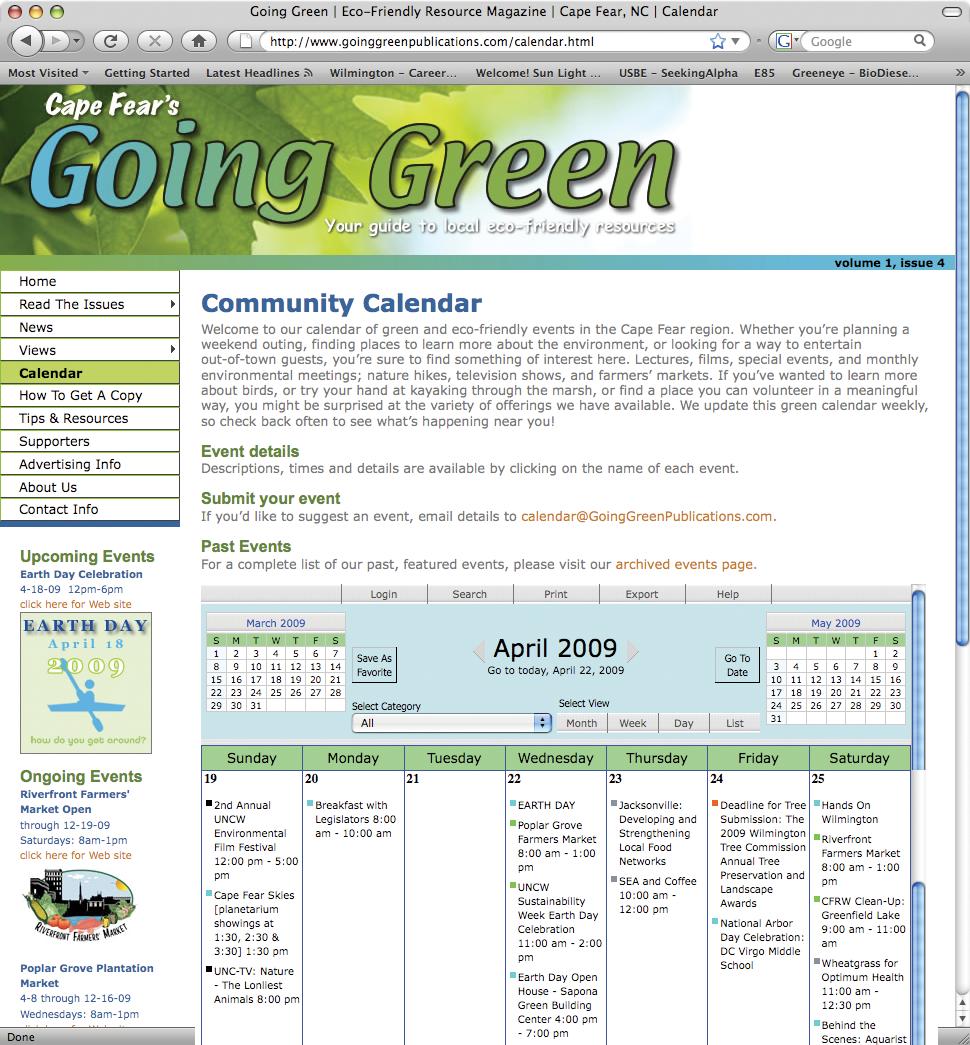
Wilmington’s Arbor Day
The Wilmington Tree Commission cordially invites you to attend their Arbor Day celebration being held on April 24 at D.C. Virgo Middle School in Wilmington.
Schedule of Events
11:00 am - Students arrive in the area of the dedication of the tree
11:10 am - Mr. Mark, the Singing Tree, will give a live performance of the Tree Rap
11:20 am - Brion Capo, Urban Forester, gives a presentation
11:30 am - Mayor Bill Saffo gives a speech
11:40 am - Dedication of tree and breaking of ground
11:50 am - Free trees are given to each student as they return to the building
D.C. Virgo Middle School is located at 813 Nixon Street, Wilmington. Phone (910) 251-6150. The school Web site is www.nhcs.k12.nc.us/virgo/. For information, contact Nicole Valentine at (910)558-7073.
Tree and Landscape Awards
Do you have a tree worthy of recognition? Do you know of such a tree, owned by someone else? On behalf of the Wilmington City Council, The Wilmington Tree Commission annually presents awards in up to nine categories, for properties located within the city of Wilmington. The awards and criteria for nominations recognize outstanding tree preservation, outstanding landscapes, and outstanding commitment to tree maintenance. Awards are presented in the following categories:
TREE CARE, MAINTENANCE AND USE
• Outstanding pruning, maintenance and/or good tree health practices.

• Outstanding tree restoration: Rehabilitation of older trees with unique character.
• Outstanding tree preservation: Preventive health practices at construction sites.
• Outstanding handling of unique location challenges: Examples include soil and water conservation, difficult topography, etc.
Tu B’shvat
A tree dedication recognizing Tu B’shvat will take place at the Temple of Israel on Sunday April 19th at 9:30am.
After Rabbi Harley Karz-Wagman gives a few words and a blessing, the children of the Hebrew School will sing songs. Following Brion Capo, our Urban Forester, will give a short presentation. Afterwards, the children will help plant the new tree.
Temple of Israel is located at One South 4th Street in Wilmington; their Web site is www.temple-of-israel.org.
LANDSCAPE DESIGN
• Outstanding use of native trees.
• Outstanding naturalized plantings: Design that simulates a natural habitat.

• Design that complements architecture or topography of site.
• Design/style appropriate to history and/or significance of the site.
• Outstanding functional design: Design that facilitates/invites pedestrian use.
Deadline for submittals is Arbor Day 2009 – April 24, 2009. Nomination forms are available at the Wilmington Tree Commission Web site: www.ci.wilmington. nc.us/Departments/PublicServices/Parks/ WilmingtonTreeCommission.aspx
For more information contact Lauren Galleher at galleherl@mac.com or (910) 520-5516.
PLAY THE GAME
I Spy a Tree... for Free
Wilmington’s Urban Forester has devised an online game to encourage people to observe the trees around them. Each month a new tree image from somewhere within Wilmington is posted at the following site:
www.wilmingtonnc.gov/tabid/290/Default.aspx
If you recognize the tree of the month, email its location according to the directions on the Web site, and you might win a tree from a local nursery!
TreeFest at Independence Mall Remains Popular
Volunteers enjoyed distributing tree seedlings at this January’s two-day TreeFest, an annual event inside Independence Mall where local residents may pick out five free bare-root seedlings to take home to plant. Crowds of people came early to stand in line for trees and expert advice on where to plant them and how to care for them; more than 10,000 are given out. The trees come from the N.C. Forest Service Nursery in Goldsboro. For information on TreeFest, please contact Jennifer O’Keefe at (910)512-6820 or jeokeefe@ nhcgov.com.
